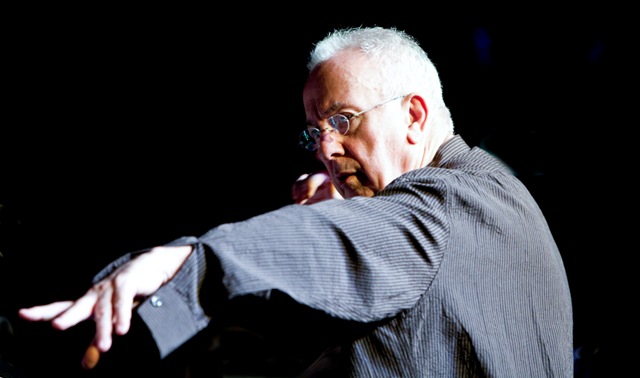
'A masterpiece doesn’t welcome understanding; its very intangibility holds its appeal' Mike Gibbs, above Photo: John Watson / jazzcamera.co.uk
Ahead of the release of Mike Gibbs + Twelve Play Gil Evans, Mike Gibbs describes the appeal of the master. Interview: Stephen Graham
“Being IN the moment of his genius usually has me in a trance,” says composer and arranger Mike Gibbs on the subject of Gil Evans. Next month in one of the most significant releases of the year so far Mike Gibbs + Twelve Play Gil Evans, a snapshot of Gibbs’ own personal take on Evans and his music, draws his own individual compositional and arranging point of view into sharp relief. “Trying to ‘understand’ it, trying to get a handle on what I’m experiencing, is always just out of reach. A masterpiece doesn’t welcome understanding; its very intangibility holds its appeal."
Gil Evans & 10 was a formative influence on Gibbs at a young age. Drawing on his memories of the album Gibbs says: “Oddly enough perhaps the aspect that springs to me first upon reflection is the wonderful sound and humanity of Steve Lacy's soprano. Gil’s writing astounded because it was made of things (instrumentation, harmony, structure) of which I thought I was somewhat versed, yet produced something beyond ‘the sum of its parts’ and was way beyond my skills. And so began a wonderful, never-ending exploration of music evolution for me via Gil’s music. Of course, other composers took my ear too, some in part due to Gil's influence. On one occasion, in a brief hang with Gil, his reminiscing about late-20s Ellington, and, in the same hang, his pressing enthusiasm for me to listen to Palle Mikkelborg’s Aura with Miles, a cassette of which he bode me listen (and to please return as it hadn’t been released at that time) sent me off on exploratory listening sprees.”
Gibbs readily refers to the challenges of tackling Evans’ work. “The main challenge was to ‘do right’ by Gil’s original scoring within the instrumental confines of the line-up available to me. The easy part was staying only with Gil’s notes, the harder part was re-deploying them instrumentally. Fortunately we did have the correct instrumentation a lot of the time. Our contribution is probably more the different personalities our ensemble gives the performances.”
Yet how did Gibbs interpret how Evans thought of himself as an arranger and how that differs from his own approach? “Boyo! I can't even begin to address that. I knew Gil personally for only a short time, in 1986 we shared guesting at the inauguration of the Orchestre National de Jazz in Paris; and although we did speak about ‘method’ a little, I cannot begin to imagine how he thought of himself. As for my own approach I'm still discovering that. It'll never be for documentation as the moment it begins to be defined, it slyly changes.
You might expect some of the songs from this 1957 album to crop up perhaps extended in some way. But no, none of them are here. Instead Gibbs tackles ‘Bilbao Song’ and takes Evans’ arrangement of Horace Silver’s ‘Sister Sadie’ from Out of the Cool recorded three years later than Gil Evans & 10.
And then there’s ‘Las Vegas Tango’ from The Individualism of Gil Evans released in 1964. And the non-Evans material: ‘Ida Lupino’, a Carla Bley tune that has appeared on several albums including Paul Bley’s trio album Closer recorded in 1965; Gibbs’ own remarkably simpàtico 3/4 tune ‘Feelings & Things’, a composition that goes back to 1967 Gary Burton quartet album Lofty Fake Anagram; Rodgers and Hart’s ‘Spring is Here’ a standard Evans had joined Miles Davis to perform at an African Research Foundation fundraiser at Carnegie Hall; Ornette Coleman’s Ramblin’ from Change of the Century released in 1960; WC Handy’s classic ‘St Louis Blues’, a composition Evans arranged for his 1958 album New Bottle, Old Wine; and another Rodgers and Hart standard, ‘Wait Till You See Her’, which appeared on Quiet Nights, Evans and Miles’ last album together released in 1964. And Gibbs’ own composition ‘Tennis Anyone’, which appeared on 1995 album Back in The Days recorded with the NDR Big Band, brings the album to a close.
Gibbs says: “The score that held the most fascination was ‘Wait Till You See Her’. It was the fullest and completest of the scores I chose. It was a transposed score (which slowed me down) where the others weren’t. Actually the others were more like elaborate piano scores, arrows pointing to notes with instrumentation instructions. Also, this score looked emptier than the sound suggested; I was held in a trance over and over again as I watched the score, after I’d had Sibelius give me a transposed version, wondering how what I heard but couldn’t see written, had been achieved.”
Mike Gibbs + Twelve Play Gil Evans is released on 12 August by Whirlwind Recordings